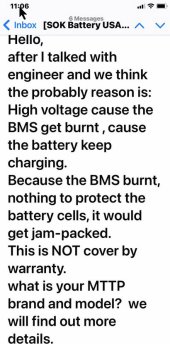You are using an out of date browser. It may not display this or other websites correctly.
You should upgrade or use an alternative browser.
You should upgrade or use an alternative browser.
SOK Troubles (user error)
- Thread starter Sabre36
- Start date
Koldsimer
Solar Addict
- Joined
- Dec 4, 2021
- Messages
- 604
Ouch! Seems pretty shifty to not cover that under warranty. A bms that fails to protect the battery module from damage under certain conditions is not the fault of the user and they shouldn't be punished for a faulty bms.
SOK should step up and replace the entire battery. End of story.
SOK should step up and replace the entire battery. End of story.
mrzed001
Voice of reason
BMS has FETs. FETs have a max V that they can resist.
If an MPPT falls short and solar V is more than the BMS FETs can handle then the BMS FETs burn to short too.
Same happened here:

 diysolarforum.com
diysolarforum.com
If an MPPT falls short and solar V is more than the BMS FETs can handle then the BMS FETs burn to short too.
Same happened here:

Why not to use Daly BMS with MPPT controllers
So there is a major problem with these type of BMS. Any thoughts?
eabyrd
Solar Enthusiast
Then the company stands by their failed BMS, no?then the BMS FETs burn to short too.
I dunno ... max series system is 48v nominal (58.4 actual) so if you connect 5 batteries in series and blow the BMS, who's to blame? Seems like the MPPT controller pushing more than 60v is the same unsupported thing. Assuming that's what happened. And seems like most BMSes will have this problem. Not just what SoK uses.
That said, I do think SoK could do a good-faith replacement. It's just one battery, one time, once from one customer.
That said, I do think SoK could do a good-faith replacement. It's just one battery, one time, once from one customer.
houseofancients
Solar Wizard
isnt this the reason to put in fuses ?BMS has FETs. FETs have a max V that they can resist.
If an MPPT falls short and solar V is more than the BMS FETs can handle then the BMS FETs burn to short too.
Same happened here:

Why not to use Daly BMS with MPPT controllers
So there is a major problem with these type of BMS. Any thoughts?diysolarforum.com
TorC
Solar Enthusiast
- Joined
- Jan 13, 2022
- Messages
- 514
@houseofancients Unfortunately a fuse only blows on amperage, not voltage, and hence won't solve the issue. The thread in the post you quoted goes on for pages of intelligent and clever people debating how to design a protection circuit that will reliably work. I've made a couple stabs at it despite my lack of EE training or experience, since I want one for the system I'm installing. I won't bother rehashing it here. It's a knotty problem.
RVLiFe
Solar Enthusiast
- Joined
- Jun 14, 2021
- Messages
- 234
It appears that this could have happened with virtually any battery. The issue was with the cheap SCC that was probably used from what it sounds. I can see why SOK doesn’t stand behind it but it is a shame that they don’t. I’d be very dissatisfied as well.
I really didn’t know that it could even be a possibility of happening even after reading hundreds of hours of threads on this forum. I do now apparently.
Glad I went with a Victron SCC but now I’m wondering if I should put in some type of sprinkler system/fire extinguisher in my RV’s battery compartment just in case.
I really didn’t know that it could even be a possibility of happening even after reading hundreds of hours of threads on this forum. I do now apparently.
Glad I went with a Victron SCC but now I’m wondering if I should put in some type of sprinkler system/fire extinguisher in my RV’s battery compartment just in case.
Last edited:
TorC
Solar Enthusiast
- Joined
- Jan 13, 2022
- Messages
- 514
RVLiFe said:It appears that this could have happened with virtually any battery. The issue was with the cheap SCC that was probably used from what it sounds.
Yes, anything that can cause an SCC to fail and put PVoc on the battery bus can do this. What makes it really hard is detecting the issue and stopping it before damage is done. Worse, there are two potential manifestations of the issue, one slow and one possibly very fast, and both must be guarded against for a reliable system. A cheap SCC makes it much more likely to happen, but it's not an exclusively cheap SCC problem.
I wouldn't put in a water sprinkler system. Now you've traded one potential issue for a much worse one.
RVLiFe
Solar Enthusiast
- Joined
- Jun 14, 2021
- Messages
- 234
I’m trying to find a Halon suppression system that I’ve seen recently on a YouTube channel.Yes, anything that can cause an SCC to fail and put PVoc on the battery bus can do this. What makes it really hard is detecting the issue and stopping it before damage is done. Worse, there are two potential manifestations of the issue, one slow and one possibly very fast, and both must be guarded against for a reliable system. A cheap SCC makes it much more likely to happen, but it's not an exclusively cheap SCC problem.
I wouldn't put in a water sprinkler system. Now you've traded one potential issue for a much worse one.
It’s designed for electrical fires but I can’t seem to find where to buy one.
Update: found it! Not cheap by any means but probably worth it.
** Fire Fight Products **
Fire Fight Products offers supplemental fire suppression systems to protect motorhomes, rvs, valuable cars, atvs, boats, homes and businesses.
www.firefightproducts.com
Attachments
Last edited:
mrzed001
Voice of reason
It appears that this could have happened with virtually any battery. The issue was with the cheap SCC that was probably used from what it sounds. I can see why SOK doesn’t stand behind it but it is a shame that they don’t. I’d be very dissatisfied as well.
I really didn’t know that it’s could even be a possibility of happening even after reading hundreds of hours of threads on this forum. I do now apparently.
Glad I went with a Victron SCC but now I’m wondering if I should put in some type of sprinkler system/fire extinguisher in my RV’s battery compartment just in case.
I think only the big (and extreme expensive) 450Voc Victron MPPT is isolated.
So only this MPPT is really protected against this failure.
And the all-in-one (original) MPP Solar/Axpert inverters, where the battery is working through an isolated DC/DC converter
mrzed001
Voice of reason
isnt this the reason to put in fuses ?
Az TorC said: fuses only protects against high Amper (and there will be max the PV generated max Ampere ... so not high) .
Does not protect against high Voltage.
BMS FETs blown too when they want to stop (open) the high V from MPPT side.
Even worst. After that the battery brings down the PV volt to its level.
So not even high V anymore.
Because high V only there on a very short time (micro to ms and after that it is only battery V) I do not think MOV or diodes can protect against it.
So if MPPT shorts there is almost no indication.
You have to measure the PV side V to see there is battery V on it.
The only reliable solution is the double V meter and a PV relay until now.
(or if you can check the BMS all the times then when it dies then to open the PV relay)
mrzed001
Voice of reason
Could you share what type of MPPT did they use that went to short ?
Thx
Last edited:
12VoltInstalls
life passes by too quickly to not live in freedom
I’d suspect that the one bms shutoff and the little homeless electrons became refugees and blew out the second bms.appears that this could have happened with virtually any battery. The issue was with the cheap SCC that was probably used from what it sounds. I can see why SOK doesn’t stand behind it but it is a shame that they don’t. I’d be very dissatisfied as well.
I haven’t seen to many (any?) stories of SCCs failing to overvolt conditions. Quitting completely is common, fuse blowing- common- but not runaway charging. Maybe I’m wrong?
mrzed001
Voice of reason
I’d suspect that the one bms shutoff and the little homeless electrons became refugees and blew out the second bms.
I haven’t seen to many (any?) stories of SCCs failing to overvolt conditions. Quitting completely is common, fuse blowing- common- but not runaway charging. Maybe I’m wrong?
FETs sometimes die.
If that FET is the only thing separating PV side from battery side in a SCC then it is like you wire the battery directly to the PV string (+diode against reverse flow).
No fuse will protect you since PV generates the usual (or less) Amper.
This is not the first MPPT short error. Not even on this forum
Halon releases a deadly gas when discharged on a fire , would not be good if released in a living environment.I’m trying to find a Halon suppression system that I’ve seen recently on a YouTube channel.
It’s designed for electrical fires but I can’t seem to find where to buy one.
Update: found it! Not cheap by any means but probably worth it.
** Fire Fight Products **
Fire Fight Products offers supplemental fire suppression systems to protect motorhomes, rvs, valuable cars, atvs, boats, homes and businesses.www.firefightproducts.com
Alkaline
Solar Wizard
If the BMS died why did it keep allowing the battery to charge unless they designed there BMS with fets that are normally closed which allowed current to keep going into the battery.
Either way this is nto acceptable, a BMS is supposed to stop the above from happening, if it detects over voltage it is supposed to shut off.
Either way this is nto acceptable, a BMS is supposed to stop the above from happening, if it detects over voltage it is supposed to shut off.
12VoltInstalls
life passes by too quickly to not live in freedom
Electronic switching of power on and off doesn’t usually insure a ‘switch’ fails open.BMS is supposed to stop the above from happening, if it detects over voltage it is supposed to shut off
Alkaline
Solar Wizard
Actually it does, that is what NO and NC means, if they wired up there fets so that they are not normally open then its default position would be to let power through, they may have done this to allow same port charging.
Now I'm not sure what fets they are using, N channel or P, but I do know if they wired them up using a pull resistor, it would effectively made the FETS a NC which would let current go through when failed.
Now I'm not sure what fets they are using, N channel or P, but I do know if they wired them up using a pull resistor, it would effectively made the FETS a NC which would let current go through when failed.
Similar threads
- Replies
- 11
- Views
- 497






